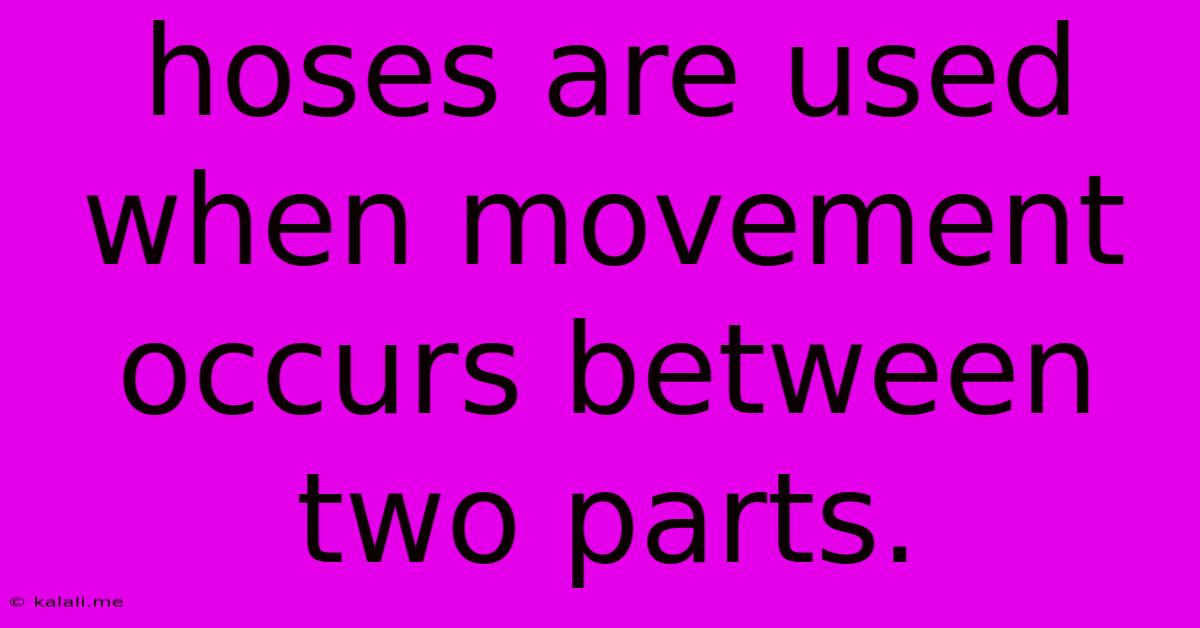Hoses Are Used When Movement Occurs Between Two Parts.
Kalali
Jun 06, 2025 · 3 min read

Table of Contents
Hoses: The Flexible Connectors Enabling Movement in Mechanical Systems
Hoses are essential components in countless mechanical systems, providing the crucial link between two parts that require relative movement. Their flexibility allows for a wide range of applications, from simple garden watering to complex industrial processes. This article delves into the various types of hoses, their applications, and the critical design considerations that make them indispensable in engineering and everyday life.
What makes hoses so vital? Simply put, they enable controlled fluid transfer, gas conveyance, or even mechanical actuation while accommodating movement between connected components. This flexibility is key in scenarios where rigid piping would be impractical or impossible.
Types of Hoses and Their Applications
The world of hoses is diverse, with each type designed for specific applications based on the fluid being conveyed, pressure requirements, and the operating environment. Here are some prominent examples:
-
Rubber Hoses: These are versatile and commonly used for general-purpose applications, such as garden watering, automotive systems (fuel lines, coolant hoses), and industrial processes handling low to moderate pressure liquids. Their flexibility and relative affordability make them popular choices. Different rubber compounds offer varying levels of resistance to chemicals, heat, and abrasion.
-
Reinforced Hoses: For high-pressure applications, reinforced hoses are necessary. These incorporate layers of fabric, wire braid, or other materials to strengthen the hose wall and prevent bursting under pressure. They're crucial in hydraulic systems, pneumatic tools, and high-pressure cleaning equipment. Examples include braided hoses and spiral reinforced hoses.
-
Silicone Hoses: Known for their excellent heat resistance and flexibility, silicone hoses are frequently used in high-temperature applications such as automotive performance modifications, industrial ovens, and medical equipment. Their resistance to chemicals and aging also contributes to their longevity.
-
PVC Hoses: Polyvinyl chloride (PVC) hoses are lightweight, durable, and resistant to many chemicals. This makes them suitable for various applications, including chemical handling, irrigation, and industrial processes requiring chemical resistance. Their affordability also contributes to their widespread use.
Key Design Considerations for Hose Selection
Choosing the right hose depends on several critical factors:
-
Fluid Compatibility: The hose material must be compatible with the fluid it will carry. Incompatibility can lead to hose degradation, leaks, and even hazardous chemical reactions.
-
Pressure Rating: The hose must have a pressure rating exceeding the maximum operating pressure of the system to ensure safety and prevent failure.
-
Temperature Range: The operating temperature range of the hose should accommodate the expected temperatures in the application.
-
Flexibility and Bend Radius: The hose's flexibility and minimum bend radius are important considerations, especially in applications requiring frequent bending or movement.
-
Durability and Abrasion Resistance: The hose material should be resistant to abrasion, weathering, and other environmental factors to ensure a long service life.
-
Length and Diameter: Proper length and diameter are vital for efficient fluid flow and compatibility with the system’s connectors.
Beyond the Basics: Specialized Hoses
The applications of hoses extend far beyond the examples mentioned above. Specialized hoses cater to unique needs, such as:
-
Vacuum Hoses: Designed to withstand vacuum pressure, essential in vacuum pumps and other suction applications.
-
Food-Grade Hoses: Manufactured from materials that meet strict food safety regulations, used in food processing and beverage industries.
-
Suction and Discharge Hoses: Designed for efficient transfer of liquids, handling both suction and discharge pressures.
In conclusion, hoses are far more than simple tubes; they are sophisticated engineering components essential for a multitude of applications. Understanding the various types of hoses and their design considerations is crucial for selecting the right hose for any specific requirement, ensuring efficient operation, safety, and longevity of the system. Careful consideration of fluid compatibility, pressure, temperature, and durability will lead to the optimal choice, ensuring seamless performance and preventing costly failures.
Latest Posts
Latest Posts
-
3 Way Light Switching Wiring Diagram
Jun 07, 2025
-
How Do You Invert A Picture
Jun 07, 2025
-
Dnd 5e So Much Homebrew Pf2
Jun 07, 2025
-
Ocarina Of Time Lost Woods Map
Jun 07, 2025
-
Mount Dry Erase Board Without Screws
Jun 07, 2025
Related Post
Thank you for visiting our website which covers about Hoses Are Used When Movement Occurs Between Two Parts. . We hope the information provided has been useful to you. Feel free to contact us if you have any questions or need further assistance. See you next time and don't miss to bookmark.